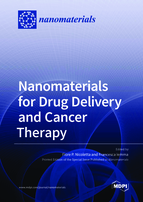Nanomaterials for Drug Delivery and Cancer Therapy
A special issue of Nanomaterials (ISSN 2079-4991). This special issue belongs to the section "Biology and Medicines".
Deadline for manuscript submissions: closed (31 October 2021) | Viewed by 38899
Special Issue Editors
Interests: chemical-physical properties of nanoparticles for drug delivery; stimuli responsive drug delivery systems; lyotropics and drug release properties; electro-optical, electrochromic, photochromic, photo-electrochromic properties of polymer films and liquid crystal dispersions; functionalization and characterization of porous membranes for membrane processes
Interests: drug delivery systems; stimuli responsive polymers; functional polymers; carbon nanocomposites; polymer therapeutics
Special Issues, Collections and Topics in MDPI journals
Special Issue Information
Dear Colleagues,
In the last decades, interest in nanomaterials as a way to fight cancer has grown rapidly. Nanoformulations are able to overcome the drawbacks related to conventional drugs, improving their pharmacokinetic profiles and treatment efficiency, and allowing multi-drug resistance reversal. Different kinds of nanomaterials are currently available, including polymer, metal, silica, carbon and hybrid nanoparticles, which are often functionalized to improve their performance in tailored applications. The multi-disciplinary topics of interest for this Special Issue include but are not limited to the development of tailored functionalization routes, the development of instrumental and functional characterization techniques, and the translational applications of nanomaterials to pre-clinical and clinical trials.
This Special Issue of Nanomaterials will attempt to cover the recent advances in the use of nanoparticle systems for cancer therapy. We welcome both research and review articles.
Prof. Dr. Fiore P. Nicoletta
Prof. Dr. Francesca Iemma
Guest Editors
Manuscript Submission Information
Manuscripts should be submitted online at www.mdpi.com by registering and logging in to this website. Once you are registered, click here to go to the submission form. Manuscripts can be submitted until the deadline. All submissions that pass pre-check are peer-reviewed. Accepted papers will be published continuously in the journal (as soon as accepted) and will be listed together on the special issue website. Research articles, review articles as well as short communications are invited. For planned papers, a title and short abstract (about 100 words) can be sent to the Editorial Office for announcement on this website.
Submitted manuscripts should not have been published previously, nor be under consideration for publication elsewhere (except conference proceedings papers). All manuscripts are thoroughly refereed through a single-blind peer-review process. A guide for authors and other relevant information for submission of manuscripts is available on the Instructions for Authors page. Nanomaterials is an international peer-reviewed open access semimonthly journal published by MDPI.
Please visit the Instructions for Authors page before submitting a manuscript. The Article Processing Charge (APC) for publication in this open access journal is 2900 CHF (Swiss Francs). Submitted papers should be well formatted and use good English. Authors may use MDPI's English editing service prior to publication or during author revisions.
Keywords
- drug delivery
- nanocomposites
- nanoparticles
- cancer therapy
- functional nanoparticles
- theranostics
- smart materials







